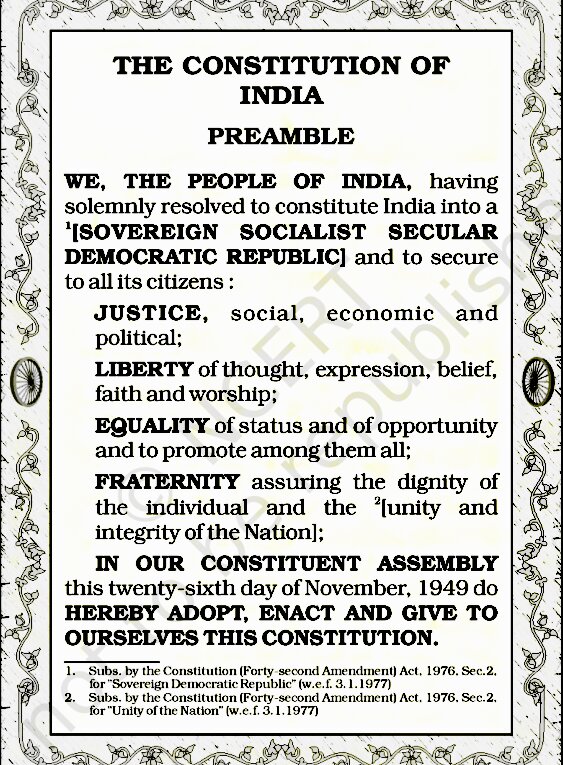The preamble to the Constitution of India is a concise and profound statement that lays down the foundational principles and aspirations upon which the Indian democracy is built. Adopted on 26th November 1949, the preamble serves as a guiding light for the interpretation and implementation of the Constitution. It encapsulates the dreams and ideals of the framers who sought to create a just, equitable, and inclusive society.
The preamble is based on the “Objective Resolutions” moved by Jawaharlal Nehru in 1946, describing the constitutional structure. On 22nd January 1947, Objective Resolution was adopted. It presented the outline of the Constitution of India and it was later reflected in the Preamble of the Indian Constitution.
“We, the people of India”
The preamble begins with the powerful phrase, “We, the people of India,” signifying the collective and sovereign nature of the Indian citizens. It emphasizes that the Constitution is not imposed upon the people, but rather a product of their own will and consent. It establishes that the ultimate authority lies with the people and that they are the foundation of the Indian democracy.
Objectives of the Preamble
The preamble enunciates the fundamental objectives that the Constitution seeks to achieve. These objectives are justice, liberty, equality, fraternity, secularism, and socialism. Let us explore each of these principles in detail:
Justice:
- The preamble aims to establish a just and fair society by ensuring social, economic, and political justice. It strives to eliminate all forms of discrimination, be it based on caste, religion, gender, or place of birth. Social justice is concerned with uplifting the marginalized and weaker sections of society, while economic justice aims to reduce socio-economic inequalities. Political justice ensures equal political rights and opportunities for all citizens.
Liberty:
- The preamble places a strong emphasis on individual freedom and liberty. It recognizes the significance of personal autonomy and the right to express one’s thoughts, beliefs, and opinions freely. Liberty includes not only freedom from external constraints but also the right to lead a life with dignity and without fear.
Equality:
- Equality is a fundamental principle enshrined in the preamble. It strives to create a society where there is equality of status and opportunity for all. The preamble rejects all forms of discrimination and promotes a sense of equality among the citizens. It recognizes that true equality requires not only legal provisions but also social and economic measures to bridge the gaps and uplift the disadvantaged sections of society.
Fraternity:
- Fraternity refers to a spirit of brotherhood and a sense of common identity among the people of India. The preamble seeks to promote unity, harmony, and a sense of belonging among the citizens. It emphasizes that despite the diverse backgrounds and differences, all Indians should strive for the collective welfare and well-being of the nation.
Secularism:
- Secularism is a key feature of the Indian Constitution, and the preamble declares India as a secular nation. It ensures that the state does not favor or discriminate against any particular religion. It guarantees freedom of religion and safeguards the rights of religious minorities. Secularism in India allows individuals to practice their faith freely while promoting religious harmony and coexistence.
Socialism:
- The preamble includes the term “socialism” to signify the commitment to achieving a socialist society. Socialism aims to ensure social and economic justice, equitable distribution of resources, and the welfare of all citizens. It emphasizes the need to alleviate poverty, reduce inequalities, and provide opportunities for all individuals to thrive and prosper.
The Moral Compass of the Constitution
- While the preamble does not grant any enforceable rights, it acts as a moral compass for the functioning of the Indian democracy. It serves as a guiding light for the interpretation of the Constitution and reminds the state and its citizens of their responsibilities and duties. The principles enshrined in the preamble form the bedrock upon which the Indian Constitution is built.
Is the preamble a part of the Indian Constitution?
Yes. The Supreme Court of India in the Kesavananda Bharti Case, 1973 declared Preamble as part of the Indian Constitution.
Is the Preamble part of the basic structure of the Constitution?
Preamble forms the part of the basic structure of the Constitution. However, Preamble is neither enforceable nor justifiable in a court of law. It means, that the courts cannot order the government to implement the ideas of the Preamble.
Amendment to the preamble
The Preamble is amendable and it has been amended only once by the 42nd Constitutional Amendment Act 1976 which added the words socialist, secular, and Integrity to the preamble.
The preamble to the Indian Constitution |
|
| Source of the Indian Constitution | The People of India are the source of the authority of the Indian Constitution. The words, ‘We, the People of India’ reflect this spirit. |
| Nature of the Indian State | The Preamble of India declares India as a sovereign, socialist, republic, secular, and democratic nation |
| The objective of the Indian Constitution | Justice, Liberty, Equality, and Fraternity are declared as the paramount objectives of the Preamble of India |
| Adoption Date of the Constitution of India | November 26, 1949, as the date of adoption. |
Conclusion
The preamble to the Constitution of India is a testament to the aspirations and ideals of the framers who envisioned a democratic, inclusive, and progressive nation. It reflects the collective wisdom and the diverse values of the people of India. The preamble provides a clear direction for the functioning of the Indian democracy, emphasizing justice, liberty, equality, fraternity, secularism, and socialism.
It serves as a reminder of the shared vision and goals that the citizens and the state should strive for. The preamble continues to inspire generations, guiding them toward building a society that upholds the principles of justice, equality, and dignity for all.
UPSC CSE Mains Questions on Preamble
- Discuss each adjective attached to the word ‘Republic’ in the ‘Preamble’. Are they defendable in the present circumstances?
- What are the basic values enshrined in the Preamble of our Constitution? How relevant are these values in the present time?
- The preamble is the philosophical key to the Constitution. Examine
- How far is the preamble useful in interpreting the Constitution?
- Bring out the philosophy of the Indian polity as enshrined in the preamble of the Indian constitution. Also, discuss various changes made to the preamble since its adoption in Indian Constitution.
UPSC Prelims Previous Year Questions
- The Preamble to the Constitution of India is
(a) a part of the Constitution but has no legal effect
(b) not a part of the Constitution and has no legal effect either
(c) part of the Constitution and has the same legal effect as any other part
(d) a part of the Constitution but has no legal effect independently of other parts
- The mind of the makers of the Constitution of India is reflected in which of the following?
(a) The Preamble
(b) The Fundamental Rights
(c) The Directive Principles of State Policy
(d) The Fundamental Duties
- Which one of the following objectives is not embodied in the Preamble to the Constitution of India?
(a) Liberty of thought
(b) Economic liberty
(c) Liberty of expression
(d) Liberty of belief
Related Articles

